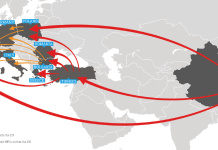Coolproducts launches a campaign to ask the European Commission to create a single energy label for both portable and wall air-conditioning units. This way, energy-greedy portable machines would not be able to bear an A- class energy label, which they now sport even though they use up to 3 times more energy per hour than wall-mounted units.
Coolproducts also aim to warn consumers about the high energy consumption of portable air conditioners so that they are better informed when buying a new unit to fight the heat -and will hopefully influence them into buying more efficient solutions this summer.
The environmental price of an impulse purchase – Quick facts and figures
Portable air conditioners are the least efficient air conditioning systems on the market – yet, they are very popular.
- In the European Union, electricity use for air conditioning is expected to rise from 40 TWh in 2020 up to 62 TWh in 2030 – the same as the residential electricity consumption of Italy.
- To cool the same area, an A+ class portable unit guzzles 2.4 times more electricity than A+ class wall-mounted systems, because their efficiency differs greatly.
- More than half a million units of portable AC were sold across the European Union only in 2015, accounting for 14,2% of the total air-conditioner sales. In Germany and Austria, more portable than wall units were sold.
- In the European Union, there are 4.3 million portable air-conditioners chilling our houses as heatwaves strike this summer, according to estimations. If turned off, every year we could save 0.35 million tonnes of CO2 – the equivalent of 200,000 round-trip flights from Brussels to New York.
We need a common label for different kinds of air-conditioning systems
The European Union does have a tool to inform buyers on the energy efficiency of new appliances: energy labels. Using a colour and letter scale, they are designed to show customers at a glance which appliances consume less electricity and help them make better choices not only for their wallets but also the planet. Unfortunately, the system does not work well in the case of air conditioners: labels on portable air conditioners are not comparable to those on wall units.
The reason is that different measurement standards exist for portable and wall units as they are understood to have different uses and therefore considered as non-comparable. Wall units are supposed to be used more regularly, to cool down larger surfaces, while portable air-cons are devised as a temporary solution. That is why an A+ class portable unit can use up to 2.4 times more electricity than an A+ class wall unit.
“Non-comparable energy labels de facto favour portable air-conditioners and thus a higher energy consumption. This leads to increased CO2 emission levels and a power grid overload. We ask the European Commission to act on this, now”, says Mélissa Zill, Energy & Climate Change Programm




